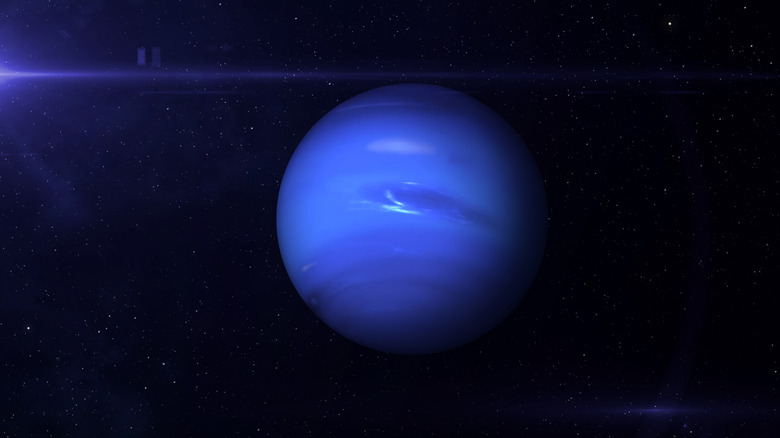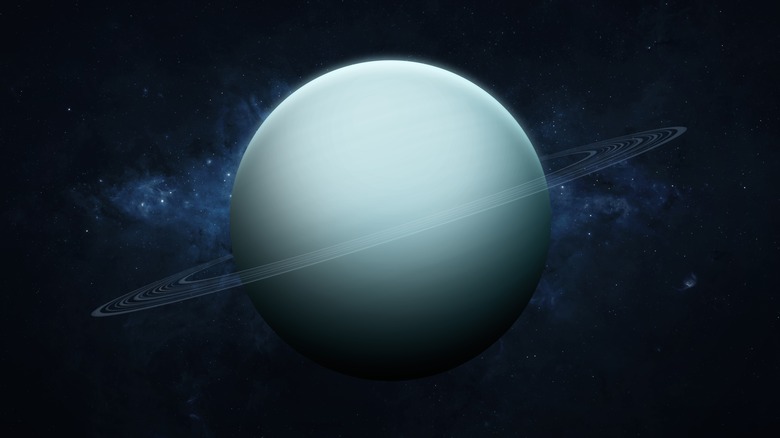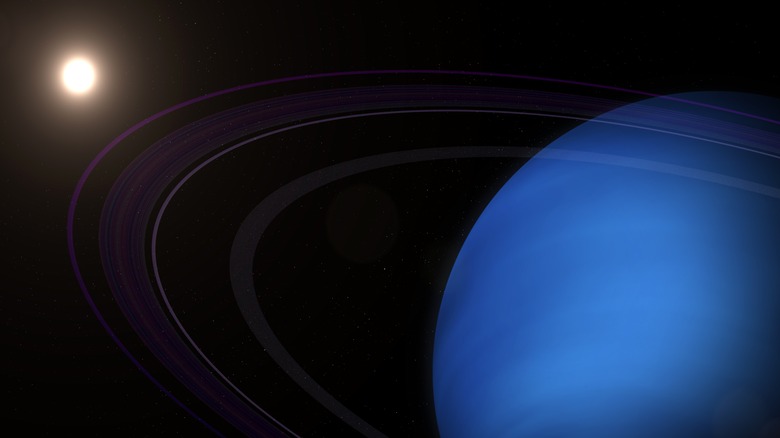Uranus And Neptune's Deepest Oceans Make Earth's Look Like Puddles
Neptune and Uranus are the seventh and eighth planets from the sun, and as such share a lot of the same characteristics. Though they are different colors (Neptune is bluer than Uranus' cyan hue) and have different numbers of rings and moons, both planets are ice giants that are similar sizes at just over 30,000 miles (50,000 kilometers) wide each. They also weigh about the same, with Neptune coming in at 1.024 x 10^26 kg (about 17 times the mass of Earth) and Uranus weighing 8.682 x 10^25 kg (about 14 times the mass of Earth). What's more, both planets have upper atmospheres made up of mostly hydrogen, helium, and methane. Put simply, then, the characteristics of Neptune and those of Uranus are very similar despite their different colors.
Now, it seems the two worlds could have yet another thing in common, and this one is particularly intriguing when compared with Earth. Neptune and Uranus might be home to some incredibly deep oceans that make our own look like puddles.
Earth's own oceans are already mysterious enough. They cover roughly 70% of the planet's surface, yet only a small portion of our ocean has been explored, with the Nippon Foundation-Gebco stating that as of June 2024, just 26.1% of the entire seafloor had been mapped. The deepest trench in the ocean, known as the Challenger Deep, sits beneath the western Pacific Ocean, southwest of the U.S. territorial island of Guam, and is roughly 35,876 feet deep. Just what life is like at such depths remains somewhat of a mystery, with the deep ocean already proving to be home to prehistoric sea animals that are, frankly, nothing short of nightmare fuel. But the deepest ocean trenches on Earth are absolutely nothing compared to the depths of the oceans that might well exist on Neptune and Uranus.
Neptune and Uranus' massive hidden oceans
In a study published by Proceedings of the National Academy of Sciences, Burkhard Militzer, a planetary scientist from the University of California, Berkeley, proposes that beneath Uranus and Neptune's atmospheres lie vast oceans that are as deep as 5,000 miles. Considering the deepest point of Earth's ocean (35,876 feet) equates to roughly 6.8 miles, that makes the oceans of Uranus and Neptune approximately 715 times deeper than our own.
Dr. Militzer used a simulation to reach his conclusion, modelling the motion of 540 atoms to produce his prediction about these gigantic ocean layers on the two planets. More specifically, his simulation produced a model of planetary layers that "separate at high pressure into an upper, water-rich and a lower, hydrocarbon-dominated layer."
The study, published in November 2024, is significant due to the fact Uranus and Neptune are the farthest planets from the sun (not counting dwarf planet Pluto) and as such have only ever been visited by one spacecraft, Voyager 2, back in 1986 and '89, respectively. Among other things, those visits revealed details about both planets' magnetic fields. But there is still so much we don't know about the two farthest planets from the sun, making Dr. Militzer's proposal all the more intriguing.
The strange magnetic fields of Neptune and Uranus
Back when Voyager 2 visited Neptune and Uranus, it discovered something unique about the planets' magnetic fields. By way of comparison, Earth's magnetic field is created by swirling molten iron and nickel in the planet's core, resulting in a north and south pole which constitutes what's known as a dipole. Earth's dipole is close to aligning with the rotational axis of the planet, but is off by about 10 to11 degrees.
But Voyager 2 discovered that Uranus' magnetic field was not only off by 59 degrees from its axis, it was offset from the planet's core by roughly one-third of the world's radius. That meant that, unlike Earth, Uranus did not have a dipole. At the time this was unprecedented, having not been observed on any other planet in our solar system. Then, when Voyager 2 visited Neptune it noted something similar. The planet's magnetic field tilted 47 degrees from its axis and was offset from its center.
On Earth, the magnetic field is produced by a process of dense materials on the surface starting to cool and sinking into the planet's interior while hotter materials rise from the interior to the surface. The resulting convection maintains this movement and mixing of materials. A magnetic dipole emerges when the core of the planet is electrically conducting, like with Earth's iron and nickel core. But on Neptune and Uranus, as Voyager 2 discovered, no such dipole exists, leading to speculation that the planets inner layers were unable to move and mix like they do on Earth and other planets in our solar system such as Jupiter and Saturn. Burkhard Militzer's study shines some light on this issue, revealing more about the inner layers of Neptune and Uranus and potentially revealing what those layers are each made of.
The layers of Uranus and Neptune revealed
Prior to his latest study, Burkhard Militzer had tried to use computer simulations to recreate the circumstances of Neptune and Uranus' formation, using 100 carbon, oxygen, nitrogen, and hydrogen atoms. Lamentably, no layers formed in this early experiment. However, Dr. Militzer's latest attempt, using 540 atoms, did result in layers forming, with the doctor saying (via Space.com) "I looked at the model, and the water had separated from the carbon and nitrogen. What I couldn't do 10 years ago was now happening."
Militzer's study suggests that beneath its atmosphere, Uranus is made up of a 5,000 mile-deep water-rich top layer, and a 5,000 mile-deep hydrocarbon-rich layer — neither of which are able to mix with each other, hence the lack of a magnetic dipole. The study also suggests a similar makeup for Neptune. In essence, then, the surface of both planets are 5,000 mile-deep oceans, though it is a little more complicated than that.
The oceans of Neptune and Uranus are unlike our own
Though it's incredible to think of an ocean that is 5,000 miles deep, especially in comparison to our own, those of Neptune and Uranus are likely nothing like what we understand oceans to be. The water-rich top layer of these ice giants would have a pressure 60,000 times greater than the pressure at the surface of Earth. That means that the "oceans" on these planets would behave more like a supercritical fluid — highly-compressed gases that have properties of both liquids and gases — than like water on Earth.
Still, a 5,000-mile deep ocean made up of a substance somewhere between gas and liquid is just as compelling as any super-deep ocean made up of water as we know it. According to Dr. Burkhard Militzer, the oceans sit atop the carbon-rich layers which are just as deep. These carbon layers then sit on top of the planets' cores. Uranus is said to have a core the size of the planet Mercury, while Neptune has a core closer to the size of Mars. All of which is both revelatory and yet, in a way, serves to make these distant planets all the more mysterious.




